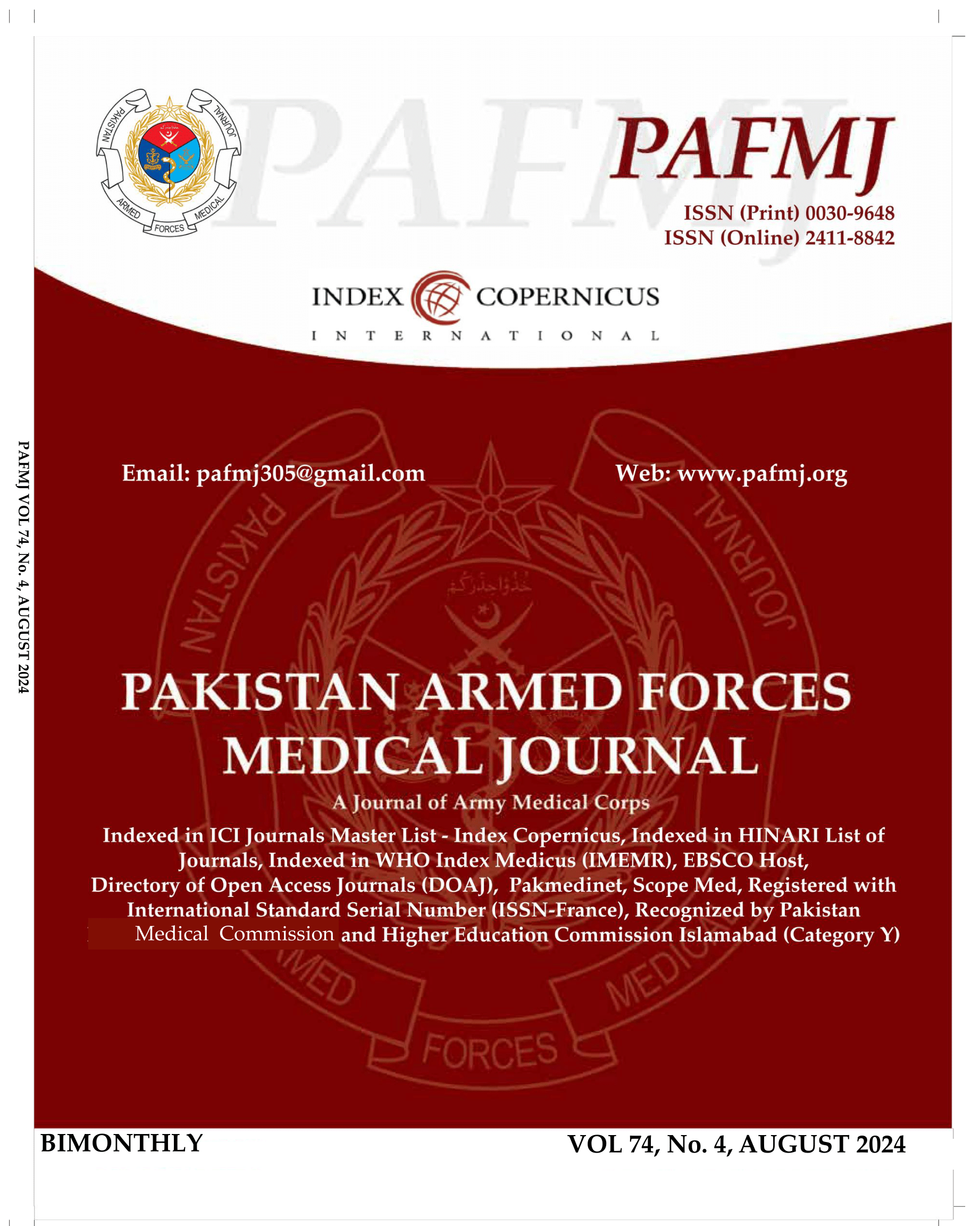Comparing The Effects of Ketamine-Midazolam Combination and Propofol on Sedation-Related Adverse Events and Quality of Magnetic Resonance Imaging in Pediatric Patients
DOI:
https://doi.org/10.51253/pafmj.v74i4.9283Keywords:
Ketamine, Magnetic resonance imaging, Midazolam, Propofol, SedationAbstract
Objective: To compare the effects of Ketamine-Midazolam and Propofol on the sedation related adverse events and quality of Magnetic Resonance Imaging in pediatric patients undergoing Magnetic Resonance Imaging under sedation.
Study Design: Quasi-experimental study.
Place and Duration of Study: Department of Anesthesia, Pak Emirates Military Hospital, Rawalpindi Pakistan, from Mar to Aug 2021.
Methodology: A total of 100 pediatric patients undergoing Magnetic Resonance Imaging under sedation were divided in to two groups, Group-A and Group-B of 50 patients each. Group-A received 1.5 mg/kg Ketamine and 0.1 mg/kg Midazolam and Group-B received 1.5mg/kg Propofol to achieve Ramsay sedation score ≥4. Bolus doses of O.50 to 1mg/kg Ketamine and 0.50- 1mg/kg Propofol were used to maintain Ramsay sedation score ≥4 during the Magnetic Resonance Imaging. Primary outcome was frequency of sedation related adverse events during Magnetic Resonance Imaging and in immediate post-sedation period. Secondary outcome was Quality of Magnetic Resonance Imaging.
Results: One (2%) patient in Ketamine-Midazolam-Group developed intraoperative hypotension versus 15(31.9) patients in Propofol -Group (p-value<0.001), which is significant. Other Intraoperative adverse effects were, bradycardia 1(2%) versus 7(14%), desaturation 0.00(0%) versus 11(23.9%), movement 4(8%) versus 3(6.4%) in Ketamine-Midazolam versus Propofol-Group with p-value of 0.020, <0.001 and 0.056 respectively. Two adverse effects seen in post-anesthesia care unit were nausea-vomiting and desaturation.
Conclusion: Ketamine-Midazolam is a better choice for sedation than Propofol due to cardiovascular stability without causing respiratory compromise and can be a useful alternative for sedation in unfamiliar environment like magnetic resonance imaging suite.
Downloads
References
Youn AM, Ko YK, Kim YH. Anesthesia and sedation outside of the operating room. Korean J Anesthesiol 2015; 68(4): 323-331. https://doi.org/10.4097/kjae.2015.68.4.323
Arthurs OJ, Sury M. Anaesthesia or sedation for paediatric MRI: advantages and disadvantages. Curr Opin Anesthesiol 2013; 26(4): 489-494.
https://doi.org/10.1097/ACO.0b013e3283620121
Lawson GR. Sedation of children for magnetic resonance imaging. Arch Dis Child 2000; 82(2): 150-153.
https://doi.org/10.1136/adc.82.2.150
Urman R, Gross WL, Philip B. Anesthesia outside of the operating room. Oxford University Press; 2011.
Artunduaga M, Liu CA, Morin CE, Serai SD, Udayasankar U, Greer MC, et al. Safety challenges related to the use of sedation and general anesthesia in pediatric patients undergoing magnetic resonance imaging examinations. Pediatr Radiol 2021; 51(5): 724-735.
https://doi.org/10.1007/s00247-021-05044-5
Jung SM. Drug selection for sedation and general anesthesia in children undergoing ambulatory magnetic resonance imaging. Yeungnam Univ J Med 2020; 37(3): 159-168.
https://doi.org/10.12701/yujm.2020.00171
Kang R, Shin YH, Gil NS, Kim KY, Yeo H, Jeong JS. A comparison of the use of propofol alone and propofol with midazolam for pediatric magnetic resonance imaging sedation–a retrospective cohort study. BMC Anesthesiol 2017; 17(1): 1-5. https://doi.org/10.1186/s12871-017-0431-2
Fonseca FJ, Ferreira L, Rouxinol-Dias AL, Mourão J. Effects of dexmedetomidine in non-operating room anesthesia in adults: a systematic review with meta-analysis. Braz J Anesthesiol 2023; 73(5): 641-664.
https://doi.org/10.1016/j.bjane.2021.12.002
Sebe A, Yilmaz HL, Koseoglu Z, Ay MO, Gulen M. Comparison of midazolam and propofol for sedation in pediatric diagnostic imaging studies. Postgrad Med 2014; 126(3): 225-230. https://doi.org/10.3810/pgm.2014.05.2770
Dala PG, Murray D, Cox T, McAllister J, Snider R. Sedation and aesthesia protocols used for magnetic resonance imaging studies in infants: provider and pharmacological considerations. Anesth Analg 2006; 103: 863-868.
Pershad J, Wan J, Anghelescu DL. Comparison of propofol with pentobarbital/midazolam/fentanyl sedation for magnetic resonance imaging of the brain in children. Pediatrics 2007; 120(3): e629-636.
https://doi.org/10.1542/peds.2006-3108
Boriosi JP, Eickhoff JC, Klein KB, Hollman GA. A retrospective comparison of propofol alone to propofol in combination with dexmedetomidine for pediatric 3T MRI sedation. Pediatr Anesth 2017; 27(1): 52-59.
https://doi.org/10.1111/pan.13041
Eastwood PR, Platt PR, Shepherd K, Maddison K, Hillman DR. Collapsibility of the upper airway at different concentrations of propofol anesthesia. Anesthesiology 2005; 103(3): 470-477. https://doi.org/10.1097/00000542-200509000-00007
Cravero JP, Beach ML, Blike GT, Gallagher SM, Hertzog JH. The incidence and nature of adverse events during pediatric sedation/anesthesia with propofol for procedures outside the operating room: a report from the Pediatric Sedation Research Consortium. Anesth Analg 2009; 108(3): 795-804.
https://doi.org/10.1213/ane.0b013e31818fc334
Acworth JP, Purdie D, Clark RC. Intravenous ketamine plus midazolam is superior to intranasal midazolam for emergency paediatric procedural sedation. Emerg Med 2001; 18(1): 39-45. https://doi.org/10.1136/emj.18.1.39
Dachs RJ, Innes GM. Intravenous ketamine sedation of pediatric patients in the emergency department. Ann Emerg Med 1997; 29(1): 146-150.
Gürcan HS, Ülgey AY, Gergin ÖÖ, Pehlivan SS, YILDIZ KM. Investigation of the effects of propofol/ketamine versus propofol/fentanyl on nausea vomiting administered for sedation in children undergoing magnetic resonance imaging: a prospective randomized double-blinded study.Turk J Med Sci 2021; 4: 2120-2126. https://doi.org/10.3906/sag-2009-98
Aycan I, Taseli Y, Temel H, Dinc B, Coskunfirat N. Magnetic Resonance Imaging under Sedation in Pediatric Patients: A Single-Institution Experience. J Child Sci 2021; e185-e192. https://doi.org/10.1055/s-0041-1731335
Uludağ Ö, Doğukan M, Kaya R, Tutak A, Dumlupınar E. Comparison of the Effects of Midazolam-Ketamine or Midazolam-Propofol Combinations on Hemodynamic Stability, Patient Comfort, and Post-anesthesia Recovery in Children Undergoing Sedation for Magnetic Resonance Imaging Procedures. Ain-Shams J Anesthesiol 2020; 12(1): 1-7. https://dx.doi.org/10.1186/s42077-019-0037-7
Downloads
Published
Issue
Section
License
Copyright (c) 2024 Waleed Ahmed Niazi, Kaukab Majeed, Najam Us Saqib, Shahid Maqsood, Adil Zafar, Arooj Ahsan

This work is licensed under a Creative Commons Attribution-NonCommercial 4.0 International License.















